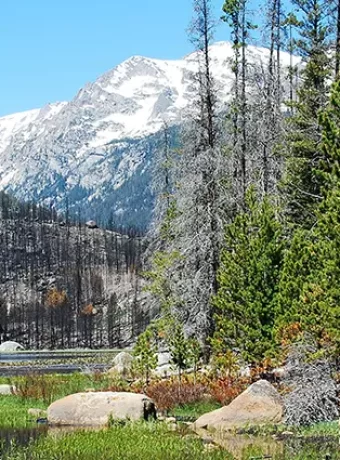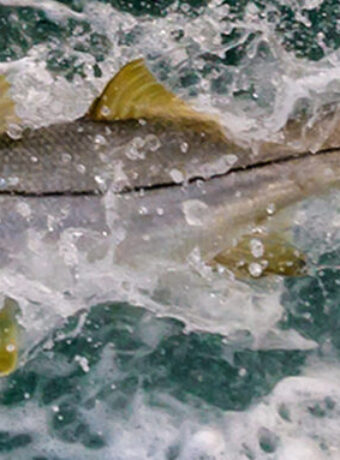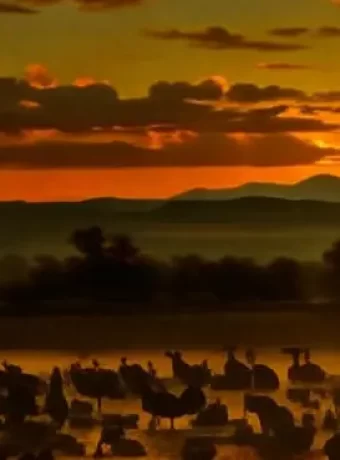History of Anaconda Montana and Fly Fish Georgetown Lake
Thinking about a trip that blends old stories with amazing outdoor fun? You have found it. We are talking about the rich History of Anaconda Montana and Fly Fish Georgetown Lake, a combination that draws people to this part of southwest Montana. This small Montana town is not just a spot on the map; it is a place where the past connects with present-day adventures, especially when you consider the History of Anaconda Montana and Fly Fish Georgetown Lake for your next getaway in Big Sky Country.
Table of Contents
The Deep Roots: Anaconda’s Past
Anaconda, Montana, located in Deer Lodge County, was not born by accident. It sprouted from the ambitions of Marcus Daly, a significant figure among Montana’s Copper Kings. In 1883, Daly recognized the need for a smelter to process ore from his copper mines in the nearby Butte area. He selected a strategic spot at the foot of the Anaconda Range, and thus, Anaconda began its journey, contributing to the vibrant western adventure narrative of the era.
The town was named after Daly’s Anaconda Copper Mining Company. This company became the community’s lifeblood for nearly a century, shaping its development and a significant portion of the southwest Montana region. By the end of the 1800s, Anaconda was a bustling center, attracting people from all over seeking work at the smelter, and it quickly became a vital part of Montana’s booming mining industry.
It is quite interesting that Anaconda almost became Montana’s state capital, with Helena narrowly winning the designation. Some historical accounts suggest that political maneuvering may have influenced the outcome, but Anaconda’s importance at the time was undeniable. The Anaconda smelter itself was a marvel of engineering. When the new smokestack was completed in 1919, it stood an impressive 585 feet tall, one of the tallest masonry structures on the planet built without internal support.
That stack, a powerful symbol of industrial might, still stands today. You can see it at the Anaconda Smoke Stack State Park, a solid reminder of the town’s powerful industrial chapter and its contribution to the state’s economy. For almost a whole century, that smelter was Anaconda’s heart, providing jobs for thousands and keeping the local economy humming, making the Deer Lodge area a center of activity.
However, circumstances change. By the 1970s, the copper business began to decline. In 1980, the smelter ceased operations permanently. This was a significant challenge for the town, but Anaconda’s resilient spirit prevailed.
The people of Anaconda are strong and resourceful. The town has since reinvented itself, becoming known as a gateway to fantastic outdoor recreation and family activities. Its fascinating past just adds another layer for visitors looking to dig deeper into local Montanas’ history Butte, Montana is just down the road to the east. Where Copper Was King.
Wandering Through Historic Neighborhoods
Anaconda’s mining history remains palpable in its four historic districts. These include the Anaconda Commercial Historic District, the Butte, Anaconda and Pacific Railway Historic District. Additionally, there are the Goosetown Historic District and the Westside Historic District. Walking through these areas, you will see many well-preserved buildings that offer a real glimpse into life during Anaconda’s heyday, a stark contrast to some of the nearby ghost towns that dot the landscape of southwest Montana.
You can take a walk through the Commercial District. Admire the late 19th-century architecture. Or, explore the Goosetown District, which was once home to immigrant workers from various parts of the world. For those wanting to learn more specific Anaconda Montana history, the Copper Village Museum and Art Center is a must-visit location.
The museum houses an extensive collection of artifacts, including mining tools, historical photographs, and exhibits that narrate the story of the town’s industrial prowess. Exploring these districts is like stepping back in time, and some visitors even make a game of spotting architectural details mentioned in local history books, perhaps found along a theoretical “bookstore trail” of Montana knowledge. The Philipsburg area, another historic mining town not too far away, offers a complementary historical experience.
Things to See and Do in Anaconda
While Anaconda’s amazing outdoor spots are a primary attraction, the town also boasts interesting cultural and historical places. These are certainly worth your time. From grand old theaters to lovely parks, Anaconda provides plenty to see and do beyond the trails and waters, making vacation planning straightforward.
Washoe Theater: A Trip to a Golden Age
One of Anaconda’s most celebrated landmarks is the Washoe Theater. It is an Art Deco marvel, wonderfully maintained since its opening in 1936. The renowned architect B. Marcus Priteca designed it. This theater is one of only a few Art Deco theaters still operating in the country and is listed on the National Register of Historic Places.
You can catch a film there or simply take a tour. The interior is breathtaking, featuring silk wall coverings, gold-covered columns, and hand-painted murals. It’s a testament to the artistic vision of its creators and a cultural gem for local Montanas and visitors alike.
Anaconda Smoke Stack State Park: A Towering Reminder
A visit to Anaconda is incomplete without seeing the Anaconda Smoke Stack State Park. This park is home to the massive 585-foot smokestack, an iconic piece of the town’s smelting legacy. While you cannot ascend the stack itself, an excellent viewpoint allows for close observation, and interpretive signs detail its history.
The stack stands as a powerful symbol of Anaconda’s industrial past and the community’s resilience. It’s a stark reminder of the industrial forces that shaped the southwest Montana region.
Lost Creek State Park: Nature’s Calm
Just a short drive from Anaconda, Lost Creek State Park offers a quiet retreat into nature and the great outdoors. It is known for its dramatic limestone formations, with cliffs rising 1,200 feet above the canyon floor. Lost Creek Falls, a picturesque 50-foot waterfall cascading over granite rocks, is another highlight. The park is also a prime location for wildlife viewing.
Visitors often spot mountain goats, bighorn sheep, and golden eagles here. The park provides opportunities for picnicking, fishing, or hiking its scenic trails. This park offers excellent family activities for those looking to connect with nature. Learn more about Montana State Parks.
Washoe Park: A Place for Everyone
Originally built by the Anaconda Copper Mining Company, Washoe Park is a cherished community space offering numerous recreational activities. The park features a duck pond, a swimming pool, and a fish hatchery, making it a wonderful destination for families. You can also stroll along the park’s paths or relax in the picnic areas, all while enjoying views of the nearby mountains in the Anaconda Range.
Old Works Golf Course: Golf on Historic Ground
Golf enthusiasts will appreciate the Old Works Golf Course. Jack Nicklaus designed this 18-hole championship course, which is uniquely built on the site of Anaconda’s original smelter. The design cleverly incorporates elements of the old industry, such as black slag for bunkers and remnants of old brick furnaces as course features.
The course offers stunning views of the Pintler Mountains. It truly exemplifies how Anaconda has repurposed its industrial heritage into something new and beautiful, becoming one of the featured experiences in this Montana region. It’s a great example of reclamation and recreational development.
Exploring the History of Anaconda Montana and Fly Fish Georgetown Lake
Now that you have a sense of Anaconda’s rich past and its local attractions, let’s discuss an adventure that brings many people to this area of southwest Montana. Just a short 15-mile drive west of town, often reached by heading a few miles west on Highway 1, lies Georgetown Lake. This is not just any lake; it is a premier destination for fly fishing in Montana. When you consider the History of Anaconda Montana and Fly Fish Georgetown Lake, this natural jewel, nestled within the Flint Creek Range, is a significant part of the allure.
This lake, a prominent feature on any region map of recreational areas, is a man-made reservoir created by damming the North Fork of Flint Creek. Its development was initially tied to providing water for mining and smelting operations, further linking it to Anaconda’s industrial past before it became the fishing paradise it is today. You might even find travel updates on lake conditions through local visitor services.
Fly Fishing at Georgetown Lake: A Montana Favorite
Georgetown Lake sits at a high elevation, 6,337 feet, and spans 3,000 acres as an alpine lake. Imagine clear water surrounded by the rugged beauty of the Pintler Mountains and the Flint Creek Range. It does not matter if you have been fly fishing for years or are just starting out; Georgetown Lake offers some of the finest fly fishing opportunities in the state, known for excellent fishing.
The lake’s ecosystem supports a thriving fishery, thanks to its cold, oxygen-rich waters and abundant insect life. Its proximity to the Continental Divide also influences its weather patterns and water conditions, making it a dynamic fishing environment. Many anglers make an annual pilgrimage to its shores, eager to experience the thrill of fishing in Big Sky Country.
What Are the Best Flies?
Georgetown Lake is teeming with various fish species. However, the primary targets for anglers are kokanee salmon, rainbow trout, and brook trout. The lake is particularly renowned for its large rainbow and brook trout, which can grow to impressive sizes in the cold, clear water.
Fly fishers often flock to the lake during the summer months. Early July is especially popular due to the damsel fly hatch, which brings large rainbow trout to the surface, actively feeding on these insects. According to Montana Fish, Wildlife & Parks, Georgetown Lake is managed for these prized species, ensuring sustainable populations for future generations of anglers. Other trout species found in the broader Flint Creek drainage include cutthroat trout, adding to the diversity of the fishery.
When’s the Best Time to Go?
The prime season for fly fishing at Georgetown Lake extends from late spring through early fall. July and August typically offer the best fishing conditions, coinciding with the damsel fly and caddis fly hatches. These hatches provide excellent opportunities for dry fly fishing. Nymphs and streamers can also be effective throughout the season.
Besides summer fishing, Georgetown Lake is a popular destination for ice fishing during the winter months, a classic Montana winter activity. Due to its high elevation, the lake freezes early. Anglers can fish for trout and salmon through the ice from December to March. Ice fishing is generally best in December, early January, and then again in March.
Tips and Techniques for Success
Fly fishing at Georgetown Lake may require a few different methods, depending on the time of year and prevailing conditions. During the damsel fly hatch, using damsel fly patterns that mimic the natural insects is crucial. In early summer, mayfly nymphs and small dry flies can also yield good results.
If you are targeting kokanee salmon, a productive tactic is to trail an egg pattern behind a streamer, using a medium retrieve. For those new to fly fishing, consider hiring a local guide from the Philipsburg area or Anaconda, or stopping by one of the nearby fly shops. They can offer valuable tips on the best flies, such as chronomids, scuds, or leeches, and methods for the lake. Local visitor services can often point you toward reputable guides and equipment rentals.
The lake features four public boat ramps, providing easy access to different parts of its waters. Renting a boat or kayak can help you reach prime fishing spots that are inaccessible from the shore. Remember to check for any travel updates or advisories before heading out, especially concerning water levels or access. Some local businesses also offer equipment rentals if you do not have your own gear.
Rules and Keeping it Great
To maintain the quality of fishing, Georgetown Lake has specific fishing regulations. Some areas have seasonal closures to protect fish during their spawning periods. For example, Stuart Mill Bay and the east and south shorelines are closed to fishing from April 1 to June 30 to allow rainbow trout to spawn undisturbed.
It is always recommended to check the current Montana fishing regulations before your trip. Anglers are encouraged to practice catch-and-release, especially for brook trout during their spawning season in the fall. Using barbless hooks is also a good conservation practice, minimizing harm to the fish. Respecting these guidelines helps preserve this fantastic fishery for everyone to enjoy, maintaining the lake’s reputation for excellent fishing.
Hiking Trails Around Anaconda: Get Out and Explore
Anaconda sits right at the base of the majestic Pintler Mountains and within the expansive Beaverhead-Deerlodge National Forest. This location makes it a dream destination for hikers, offering a portal to the great outdoors. It does not matter if you prefer a relaxed walk or a challenging backcountry expedition; the area boasts numerous hiking trails near Anaconda suitable for every skill level. Many trails offer breathtaking views synonymous with sky country.
Before heading out, consider stopping by a local shop or purchasing the right trail maps or advice; Finding the perfect camp site near a trailhead can enhance your hiking adventure.
Make sure the look into a great backcountry experience in the Anaconda-Pintler Wilderness.
Twin Lakes Trail
The Twin Lakes Trail is a popular choice. It provides amazing views of alpine lakes and the surrounding mountains of the Anaconda Range. The trailhead is not far from Anaconda; you take MT-1 N and then Twin Lakes Creek Road. The hike is approximately 7 miles round-trip and is generally considered moderately difficult, with about 1,000 feet of elevation gain.
As you hike, you will pass through lodgepole pine forests and open meadows before reaching the beautiful Twin Lakes. The trail offers fantastic opportunities for wildlife viewing.
Storm Lake Loop
If you are looking for a more strenuous hike, the Storm Lake Loop is an excellent option. This 3.5-mile loop circumnavigates Storm Lake, a stunning alpine lake surrounded by towering peaks. The trail features some steep sections and rocky terrain, making it better suited for hikers with some experience.
The loop offers breathtaking views of the Pintler Mountains. It is also a good place to spot wildlife; you might see deer, elk, or even moose foraging in the area.
Continental Divide Trail (CDT) via Seymour Lake
Anaconda serves as a gateway to the Continental Divide Trail (CDT), one of the most famous long-distance hiking trails in the United States. This iconic divide trail stretches for thousands of miles. You can access a segment of the CDT from the Seymour Lake trailhead, reachable by taking MT-1 S and then Seymour Lake Road. From the trailhead, you can follow the trail for several miles along Seymour Creek, enjoying a relatively quiet part of the CDT that does not see heavy foot traffic.
If you desire a longer trip, you can continue to Upper Seymour Lake, an amazing alpine lake tucked into the mountains. This section of the trail showcases the rugged beauty of southwest Montana and the Continental Divide.
Denton’s Point Trail
For a hike the whole family can enjoy, Denton’s Point Trail at Georgetown Lake is a perfect pick. This 1.5-mile trail is quite easy, with minimal elevation gain, making it suitable for all ages and a great option for family activities. The trail runs along the shore of Georgetown Lake, offering lovely views of the water and the surrounding mountains.
Along the way, you can stop at picnic areas or even try fishing from the shore. It’s a wonderful way to experience the beauty of Georgetown Lake southwest Montana without a strenuous climb.
Lost Creek Falls Trail
You will find the Lost Creek Falls Trail inside Lost Creek State Park. It is a short hike, but it is very rewarding. The trail is only about half a mile round-trip and leads you to a beautiful 50-foot waterfall that flows over granite cliffs. The trail is paved and easy to walk, which makes it an excellent choice for families or those seeking a quick immersion in nature. Nearby, the Discovery Basin ski area, a few miles north of Georgetown Lake, offers winter activities like skiing and snowboarding, and summer activities like mountain biking.
Exploring these trails, or even venturing towards other known fishing waters like Rock Creek, the Big Hole River, or the Clark Fork River, provides a true sense of the Montana region. For those interested in history, the Vigilante Trail, a historic route in southwest Montana, offers another way to explore the area’s past, perhaps passing near Virginia City, one of the state’s most famous ghost towns. Various lodging options, from vacation homes and springs resorts to ranch vacations, cater to visitors.
Conclusion of Anaconda Montana and Fly Fish Georgetown Lake
Anaconda, Montana, truly offers a wonderful mix where the past meets thrilling outdoor fun. From its beginnings as a copper smelting giant to its current role as a portal to the Pintler Mountains and the Anaconda Range, Anaconda gives visitors a fantastic blend of interesting historical sites and natural wonders like Silver Lake. Whether you find yourself exploring the grand Washoe Theater, seeking excellent fishing with a fly rod at Georgetown Lake for rainbow trout or kokanee salmon, or trekking along the Continental Divide Trail, the experience tied to the History of Anaconda Montana and Fly Fish Georgetown Lake is something you will remember.
This town, a key part of the Deer Lodge county area, is ready for you to discover its stories, its welcoming local Montana’s, and its wild beauty. With careful vacation planning, using resources like a free travel guide for southwest Montana, you can craft an unforgettable western adventure in Big Sky Country. Don’t forget to check out nearby attractions such as hot springs resorts or the Discovery Basin ski area for year-round enjoyment.






